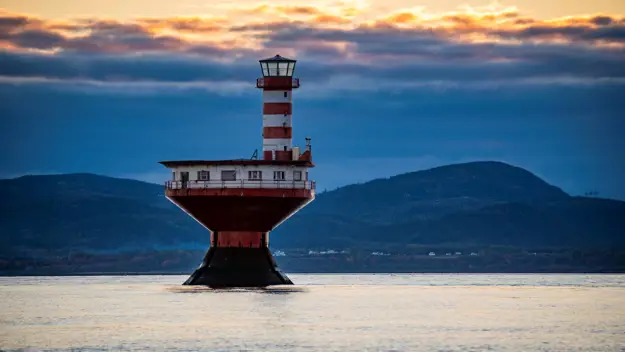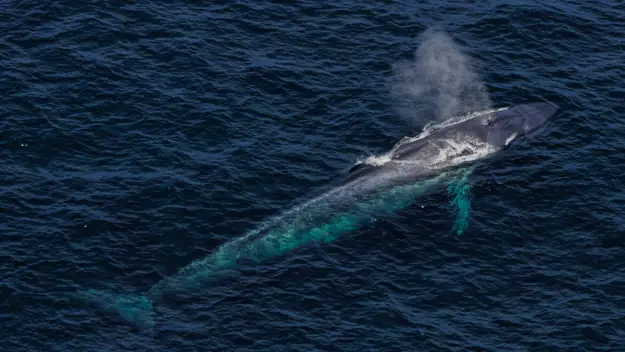The St. Lawrence River has shaped the province of Quebec in many ways. It first served as a gateway for the early explorers of New France, it is now Canada's most important commercial route and waterway. The river and its natural beauty shaped Quebec’s landscape.
The river as a whole is not just a river but also a gulf that extends from the Magdalen Islands to as far as Pointe-des-Monts on the North Shore. It then becomes an estuary as far as Lake Saint-Pierre, where it transforms back as a river. At the time, the St. Lawrence was the only gateway to the heart of the continent. First nations, long before the first settlers, had been navigating the St. Lawrence River for thousands of years. They were the first people to depend on the river for food and transportation.
Characteristics of the river
The St. Lawrence River takes its source from the overflow of Lake Ontario and then flows north-eastward to Montreal, Quebec City and into the St. Lawrence Gulf. Although it seems to have been part of the Quebec landscape for ages, it considered a young river from a geological point of view. Its bed corresponds to a deep fissure in the earth's crust, discovered nearly 10,000 years ago when glaciers retreated from the Champlain and the Goldthwait Sea.
There are many vantage points where you can admire the St. Lawrence and being on the water is the perfect opportunity to do so! When you are aboard an embarcation in the middle of the St. Lawrence, you feel quite small compared to its density. In fact, the river forms, with the Great Lakes, a hydrographic network that stretches over 3058 kilometres inland in North America. Doing a cruise is a great way to observe this majestic waterway.
Marine life Observation
The Quebec Maritime Regions are among the best places in the world for whale watching. The Saguenay-St. Lawrence Marine Park is renowned worldwide for whale watching! This 1245 kilometres square area is a prized amongst marine mammals because of the food concentration found there. The tide interaction in the Laurentian Channel creates a very interesting feeding basin for whales.
It is possible to observe some of the 13 species of the St. Lawrence marine mammals aboard the AML Cruises fleet. It's a great opportunity to see them in their natural environment while respecting their ecosystem. In order to protect marine wildlife and respect whales, all captains, who offer whale watching excursions, receive training from Parks Canada on what to do to minimize whale disturbance.
AML Cruises also participated in the creation of Alliance Éco-Baleine, an organization committed to implementing responsible whale-watching practices in the Saguenay-St. Lawrence Marine Park. Its collaborative actions have led to the development and implementation of the industry’s best practices.
The Saguenay-St. Lawrence Marine Park has a rich biodiversity that can be observed when cruising the Saguenay Fjord. Passengers are amazed when they get the chance to glimpse a whale tail emerging from the water or seals napping on rocks near the shore. The whale-watching season generally runs from May to October, sometimes extending until November.
You can also enjoy breathtaking views when sailing on the Saguenay River. The river takes its source in Lac Saint-Jean and is divided into two waterways, the Petite and Grande Décharge. Its watershed extends to 698 kilometres long, from the Péribonka River to the St. Lawrence. That's about 80 times the size of Mount Everest!
These two rivers meet at the height of the Pointe des Américains in Alma, which marks the beginning of the Saguenay River, in the form of a reservoir several kilometres long. When it reaches Shipsaw, the river runs through two hydroelectric power stations. The Saguenay River splits into two again, between Chicoutimi and Jonquière. The two dam reservoirs join and form the Saguenay River. The Saguenay is now open to navigation. At Saint-Fulgence, the Saguenay Fjord begins at the sand spit. It can be distinguished from the river by its salty water.
What distinguishes a fjord from a river?
A fjord is an ancient glacial valley whose bed is at sea level. As the ice retreats from the valley, the water is free to move inland, forming a fjord. The fjord is part of the Saguenay River.
Fjords have breathtaking landscapes and are characterized by colossal walls of rock located across a dense stretch of water. Cruises with AML Cruises allow you to admire the fjord's natural beauty. Near Sainte-Rose-du-Nord, you'll have the chance to observe these immense cliffs. From Saint-Fulgence to Tadoussac, the fjord dimensions are impressive. With a length of 105 kilometres and a width of about 1 to 3.5 kilometres, the fjord represents a deep gash in the Laurentians. The Saguenay River also flows through the most southerly fjord in the world, the only navigable one in all of North America.
An emblem of the river
There are more than 40 lighthouses along the shores of the St. Lawrence River. For a long time, their role was to ensure the safety of mariners, but today they have become guardians of our heritage. In fact, one of the emblems of Tadoussac is the lighthouse located between the St. Lawrence River and the Saguenay Fjord. Its official name is the Phare du haut-fond Prince but you'll hear locals call it "la toupie". This lighthouse has been part of the St. Lawrence landscape since it was built in 1905. Located in the middle of the St. Lawrence River at the mouth of the fjord, this 25.3-metre tower has quite a rich history, since its inauguration in 1964.
It was built on a shoal, considered one of the most dangerous of the river. This watchtower was first designed to withstand the pressure of ice. Its location on the river is about 23 kilometres-wide, leaving a lot of space for ice to circulate. Below the lighthouse is a conical base in a platform configuration on which stands a cylindrical tower, hence its nickname la toupee (spinning top). The Phare du haut-fond Prince is known for its horizontal red and white stripes.
The first year of its conception marked the Tadoussac population's imagination. During the first winter, a storm ravaged the middle of the St. Lawrence River where the lighthouse was located. With a rising tide about to wreak havoc, the lighthouse was battered and the doors began to tear off. Waves then began to wash over the lighthouse and three keepers had to take refuge in the generator room to issue a distress call. However, the ships were unable to help the three men because of the storm's violence. Just as they thought they would die during the night, the tide slowly began to recede and the wind diminished in intensity. After a while, the keepers discovered that the storm had completely destroyed the village. They were evacuated by helicopter.
To this day, the lighthouse remains emblematic for locals. Ship captains often go to visit "la toupie" during cruises. In fact, the lighthouse is one of the best places for whale watching, which you can enjoy with one of the many AML Cruises offered.
AML Cruises offers several types of expeditions departing from the Tadoussac Pier. Passengers can choose a cruise according to their preferences. Aboard the AML Grand Fleuve, a large comfortable ship, set out for a memorable 3-hour adventure. Enjoy an exceptional panoramic view and discover the Saguenay-St. Lawrence Marine Park, an ideal location for whale watching.
Adventure seekers who wish to be in the heart of the whale's habitat will instead choose to board a Zodiac! The captains aboard are all certified naturalists. They know all the St. Lawrence marine life secrets and enjoy sharing their knowledge with their passengers.
A seaplane expedition will please thrill seekers! AML Cruises offers a memorable flight with Aviation du Fjord. The seaplane provides an exceptional view of the Saguenay Fjord. You will depart from Lac Long, near Tadoussac, and fly at an altitude of 600 metres-high.
The different faces of the St. Lawrence
More than a landscape, the St. Lawrence is also an important economic source in Canada. Did you know that 90% of the world's goods are transported by ship? The majority of the objects we use are transported daily by the St. Lawrence River, whether it's our furniture, clothing or electronics. Always in action, Quebec's port network includes 20 ports and transports about 110 million tons of goods, including food and minerals, every year. This waterway offers jobs and products essential for consumption.
Whether it is visited on vacation, observed with its marine wildlife or used for a source of income, the St. Lawrence River is part of Quebecers' daily lives. From Montreal to Saguenay, the St. Lawrence River metamorphoses and offers a different vantage point depending on where you look from. It is one of Quebec's historical staples.




